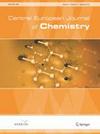Influence of temperature on the reduction kinetics of Bi(III) ion in the presence of cystine in chlorate (VII) solutions of decreased water activity
引用次数: 2
Abstract
AbstractThe results of the kinetic measurements of Bi(III) electroreduction on a mercury electrode in 1–8 mol dm−3 chlorate (VII) solutions and in the presence of cystine demonstrate a dependence of the process on the temperature. The applied electrochemical techniques (DC polarography, cyclic and SWV voltammetry) allowed for the determination of the kinetic and thermodynamic parameters and their correlation with water activity. The catalytic activity of cystine was confirmed by the decrease in overall enthalpies of activation. The changes in the values of ΔH≠ and ΔS0 for Bi(III) electroreduction in the presence of cystine with the increase of chlorate (VII) concentration showed that the mechanism is different in solutions with low water activity as compared to those with high water activity. Probably it is connected with a different structure of the activated complexes (Bi-Hg(SR)2), mediating electron transfer.温度对水活度降低的氯酸盐(VII)溶液中胱氨酸存在下Bi(III)离子还原动力学的影响
摘要在1-8 mol dm−3氯酸盐(VII)溶液和胱氨酸存在下,在汞电极上电还原Bi(III)的动力学测量结果表明,该过程与温度有关。应用电化学技术(直流极谱法、循环伏安法和SWV伏安法)可以确定动力学和热力学参数及其与水活度的关系。胱氨酸的催化活性通过总活化焓的降低得到证实。胱氨酸存在下Bi(III)电还原的ΔH≠和ΔS0值随氯酸盐(VII)浓度的增加而变化,表明低水活度溶液与高水活度溶液的电还原机理不同。它可能与活化配合物(Bi-Hg(SR)2)的另一种结构相连接,介导电子转移。
本文章由计算机程序翻译,如有差异,请以英文原文为准。
求助全文
约1分钟内获得全文
求助全文

 求助内容:
求助内容: 应助结果提醒方式:
应助结果提醒方式:


